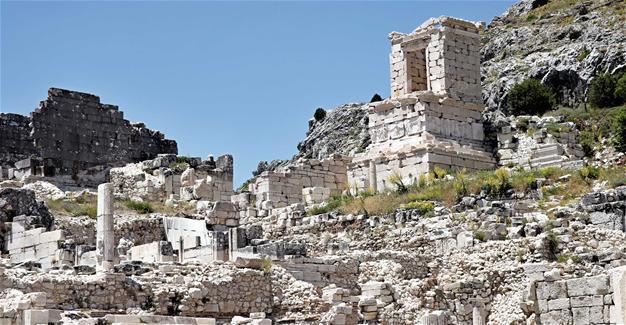New excavation season starts in ancient Sagalassos
BURDUR-Anadolu Agency

Excavation and restoration work has resumed in the ancient city of Sagalassos in the southern city of Burdur’s Ağlasun district.
According to written sources, the history of Sagalassos dates back to 333 B.C. when it was conquered by Alexander the Great. The city had been one of the five most important ceramic production centers in the Roman era.
A team of 90 people from different countries will work in the excavation area this year and the works will continue for the next three months. A team of five experts from the city’s Mehmet Akif Ersoy University (MAKÜ) will give academic and technologic support to the excavation.
The head of the excavation team, Professor Jereon Poblome, said the most excavation would be done in the ancient agora area.
“Our biggest excavation will take place in the eastern part of the upper agora, as the oldest building of Sagalassos was found there two years ago. As far as we have learned, there was a trade building in this area. This building was constructed in the second century B.C. and is the oldest official building of Sagalassos. Here is a rich place and our building is standing. We will open the top of the building and reread history,” said Poblome and added that the restoration works will go hand in hand with the excavation works.
He also noted their aim was to prepare for the opening of the site to visitors as soon as possible.
“A special kind of tablet was found here last year. This is of great importance both for Sagalossos and the Roman Empire, as it mentions its governors. We will focus on the mortared stone this year and will proceed with the monumental columns,” Poblome noted.
“The group will work with the MAKÜ team at a large mausoleum area, which has opened recently. Then, we will continue on the hillside of the whole site, on which there is a castle. We have yet to learn exactly when the castle was erected, but it can probably be traced back to the Hellenistic time or the Byzantine era,” he noted, adding the team also had restoration works at a Roman bath on site.
Excavations in the city were originally initiated in 1989 by Belgian Professor Marc Waelkens.
Professor Poblome from the Belgian Leuven Catholic University was the deputy head of excavations who replaced Waelkens when he retired two years ago.
A team of Turks and foreigners led by Leuven University have been continuing excavations in the ancient city of Sagalassos for years, with their work inspected by the Ministry of Culture and Tourism. Among the artifacts unearthed were five-meter-tall sculptures of Emperor Marcus Aurelius and Emperor Hadrian.
Among the other significant artifacts unearthed in the city are friezes of a dancing girl and sculptures of the goddess of victory Nike and Dyonisos, Nemesis, Asklepios and Kronis.
The ancient city had been founded on the slopes of the Taurus mountain range and had been the metropolis of the Roman province of Pisidia. It is seven kilometers away from the Ağlasun district. The city is on the UNESCO Tentative World Heritage List.
 Excavation and restoration work has resumed in the ancient city of Sagalassos in the southern city of Burdur’s Ağlasun district.
Excavation and restoration work has resumed in the ancient city of Sagalassos in the southern city of Burdur’s Ağlasun district.